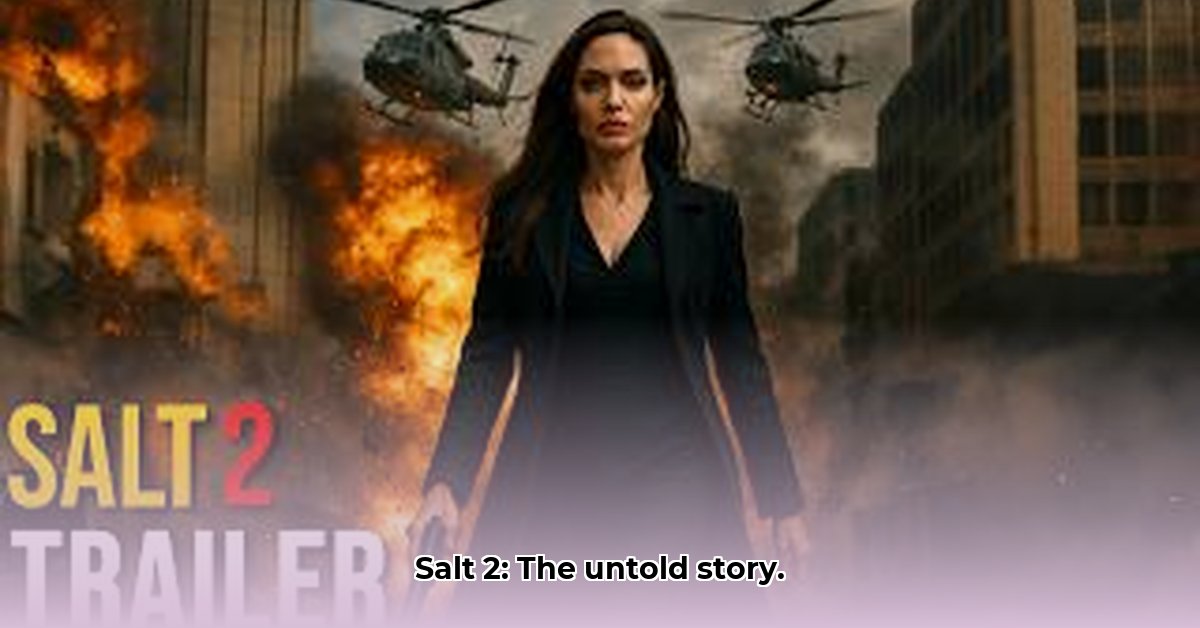
Remember Angelina Jolie, kicking ass and taking names as Evelyn Salt in the 2010 action thriller? That adrenaline-pumping ride left us on a cliffhanger, practically begging for a sequel, Salt 2. But why did this potential blockbuster never materialise? The answer isn't a simple one, tjom, it's a complex tale of box office realities, creative clashes, and changing career ambitions. Let's delve into the behind-the-scenes drama that ultimately grounded Evelyn Salt's next mission.
Salt 2 Film: The Untold Story Behind the Cancelled Sequel
Salt, released in 2010, wasn't a flop. Globally, it raked in a respectable R3.7 billion (approximately $293 million). But in the cutthroat world of Hollywood, "respectable" doesn't always equate to "sequel-worthy". While it comfortably covered its R1.2 billion (approximately $110 million) budget, it didn't quite reach the blockbuster heights needed to justify the massive investment a big-budget action sequel demands. This, my friends, was the first stumbling block. The film made a profit, yes, but not enough to scream "Sequel!" from the mountaintops.
Then came the script – or rather, the lack of a satisfactory script. Industry whispers tell of numerous rewrites and significant creative disagreements. Some say Angelina Jolie herself rejected several proposed scripts, highlighting the considerable creative hurdles. It wasn't just a case of adding more explosions; they needed a story that built upon the first film's success, a compelling narrative that could capture audiences' imaginations – a task that proved far more difficult than expected.
Beyond the script's woes, Angelina Jolie's career took a fascinating turn. Post-Salt, she focused intensely on directing and her extensive humanitarian work. Suddenly, even lucrative blockbuster franchises took a backseat to her evolving priorities. Was she simply ready to move on from Evelyn Salt? Perhaps. Or maybe her ambitions simply outweighed the appeal of another Salt instalment. It wasn't a case of unwillingness to work, but a shift in what she wanted to work on.
Adding to the chaos, the original director, Phillip Noyce, departed. This led to a revolving door of directors and screenwriters, each bringing their own vision, resulting in a confusing mishmash of ideas. It's like trying to bake a koeksister with a dozen different bakers – the end result bears little resemblance to the original recipe. A cohesive vision is crucial for a sequel, especially in the action genre.
Furthermore, Salt, while undeniably entertaining, didn't revolutionise the spy thriller genre. It played it safe, sticking to familiar territory in a market already saturated with similar films. To justify a sequel, you need a unique hook – something new and exciting that can grab audiences' attention. Salt simply didn't offer that groundbreaking element to warrant a sequel in such a fiercely competitive landscape.
A Salt TV series was even briefly considered, but that too fizzled out. Shows like The Blacklist had already explored similar territory, and Jolie's waning interest in the franchise, along with the lack of a strong, fresh narrative angle, effectively killed that idea as well.
The demise of Salt 2 wasn’t a single, catastrophic event, but a perfect storm: moderate box office success, creative clashes, Jolie’s shifting career focus, directorial changes, genre saturation, and the near-impossible task of crafting a sequel that felt both familiar and innovative. The stars, quite simply, didn't align.
But what could have been? Imagine a Salt 2 storyline: Evelyn Salt facing a more personal threat, or a global conspiracy that tests her limits. The possibilities remain tantalising, a frustrating reminder of what might have been.
Key Factors That Doomed Salt 2
Moderate Box Office Success: Salt performed well, but not well enough to guarantee a sequel's financial viability. It made a profit, but not the blockbuster returns needed to justify the substantial investment in a large-scale action sequel.
Creative Conflicts and Script Issues: The failure to develop a compelling script that satisfied both the studio and Angelina Jolie proved a significant roadblock. Multiple rewrites and creative disagreements stalled the project's progress.
Angelina Jolie's Career Shift: Jolie's evolving career priorities, with a greater focus on directing and humanitarian work, diminished her interest in returning to the role of Evelyn Salt, or at least, participating in a project whose direction she disagreed with.
Directorial and Scriptwriting Instability: The departure of the original director, Phillip Noyce, and the constant changes in the writing team prevented the creation of a consistent creative vision for the project.
The story of Salt 2 serves as a compelling case study in Hollywood's complexities. It highlights the multitude of factors that can contribute to a project's downfall, even when the original film enjoys reasonable success. It's a reminder of just how precarious balancing many factors, often external to creative considerations, can be. And despite the unfinished business, the lingering "what if?" continues to fascinate.